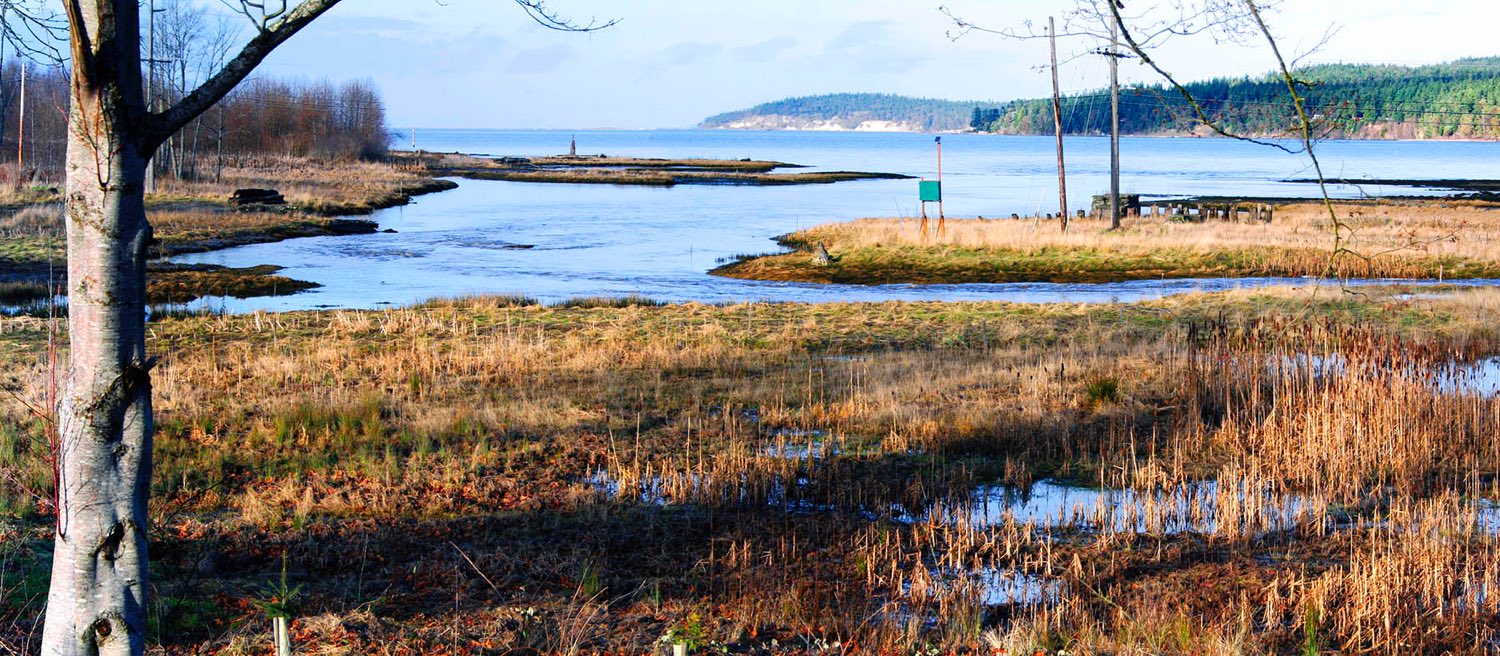Partners restore imperiled summer chum salmon and shellfish in Clallam County
Jimmycomelately Creek and its estuary in Clallam County are now home to a robust population of ESA-listed summer chum salmon as well as a thriving commercial shellfish operation. This vibrant creek and estuary in Sequim Bay benefited from habitat restoration work accomplished from 1997 to 2005 and led by the Jamestown S’Klallam Tribe and supported by 27 partners. Restoration work included acquiring more than 90 acres of riparian and estuary habitat to restore and set aside for conservation; realigning the lower ½ mile of creek to a natural meandering configuration; planting native trees along the creek and installing large woody debris in the creek to create pools where salmon can rest; restoring 4.5 acres of saltmarsh habitat; removing two roads, an RV park, a commercial log yard, and creosoted pilings from the estuary; and replacing an undersized culvert on the creek at Highway 101 with a 100-foot bridge. Restoring the creek’s natural meandering allowed the stream to reconnect with its floodplain and allows silt to drop out before it reaches the estuary. A dense riparian forest and deep pools resulted in measurably cooler creek temperatures following restoration. Removing creosoted pilings eliminated toxics that can harm aquatic life and eliminated artificial perches for fish-eating birds in the estuary’s migration corridor for juvenile salmon. Restoration work improved the estuary for shellfish by causing silt to flush away. Productive sand and gravel flats have naturally replaced expanses of mud in the estuary. Today the Jamestown S’Klallam Tribe operates year-round commercial shellfish operations in the estuary. By restoring tidal exchange and upsizing the crossing on Hwy 101, water now flows naturally in the creek and estuary and chronic flooding along Highway 101 was eliminated. In 2015, more than 6,500 naturally spawned summer chum returned to the creek. Investing in Jimmycomelately Creek rescued summer chum from near extinction, reestablished shellfish beds in south Sequim Bay, and reconnected the Tribe with historic cultural resources.
What worked:
- Realigning the creek channel and planting trees along the creek bank cooled the water for summer chum salmon.
- Realigning the creek and adding large wood to the stream created better habitat for salmon to lay their eggs.
- The number of adult chum salmon increased from 7 in 1990 to more than 6,500 in 2015.
- Removing creosoted pilings eliminated artificial perches for fish-eating birds that preyed on juvenile salmon.
- Restoring the natural tidal connection between the creek and the estuary flushed mud from the estuary and allows sand and gravel to move from the creek into the intertidal area and create productive shellfish habitat.
- Replacing the Highway 101 bridge prevented flooding and ensures free access to upstream areas for salmon.
Benefits:
- Restored tidal exchange will continue to naturally build habitat for fish and wildlife.
- Tidal channels provide habitat for young salmon to acclimate to the change from freshwater to saltwater.
- Salmon will have more habitat to feed and grow before going out to the ocean.
- Removal of creosote logs and pilings reduced toxics that harm salmon.
- Jamestown S’Klallam Tribe can farm and harvest shellfish commercially.
Location:
- Congressional District: 6
- Legislative District: 24
- WRIA: 17
- County: Clallam
Partnerships:
- Jamestown S’Klallam Tribe
- Clallam County
- Washington Department of Fish and Wildlife
- North Olympic Land Trust
- Natural Resources Conservation Service
- Clallam Conservation District
- US Fish and Wildlife Service
- EPA
- Private property owners
Project Funding:
- Salmon Recovery Funding Board
- Puget Sound Acquisition and Restoration Fund
- Aquatic Lands Enhancement Account
- Centennial Clean Water Fund
- Washington Wildlife and Recreation Program
- US Fish and Wildlife Service National Coastal Wetlands Conservation Grant

